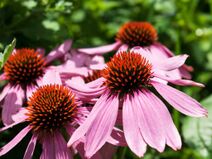Echinacea angustifolia
| Echinacea angustifolia | |
 | |
| Light: | |
| Moisture: | |
| Hardiness: | 3 |
| Soil pH: | 5.6-8.4 |
| Height: | 4' |
| Width: | 1' |
| Blooms: | Mid Summer-Late Summer |
| Native to: | |
| Nectary | |
| Medicinal Rating: | |
| Tea: | Yes |
Echinacea angustifolia (common names: echinacea and narrowleaf coneflower)
Propagation: Seed - sow March/April in a greenhouse and only just cover the seed[1][K]. Diurnal temperature fluctuations aid germination[1]. The seed usually germinates in 10 - 21 days at 25°c[1]. Prick out the seedlings into individual pots once they are large enough to handle and grow them on in the greenhouse for the first summer. Plant them out in the late spring or early summer of the following year and give them some protection from slugs at least until they are established[K].
Division in spring or autumn[2]. Larger clumps can be replanted direct into their permanent positions, though it is best to pot up smaller clumps and grow them on in a cold frame until they are rooting well. Plant them out in the spring.
Root cuttings, October in a frame[3].
Cultivation: Prefers a deep rich loam with plenty of leafmold[4] and a sunny position[1].
Closely related to E. pallida and included in that species by some botanists[5].
Slugs love this plant[K].
Range: N. America - Manitoba, Saskatchewan and North Dakota south to Texas.
Habitat: Gravelly, sandy, and rocky dry limestone prairies and barrens[6][5].
Medicinal: Echinacea is one of the world's most important medicinal herbs. Research shows that it has the ability to raise the body's resistance to bacterial and viral infections by stimulating the immune system[7]. It is also antibiotic and helps to relieve allergies[7]. Plants in this genus were probably the most frequently used of all North American Indian herbal remedies. They had a very wide range of applications and many of these uses have been confirmed by modern science. The plant has a general stimulatory effect on the immune system and is widely used in modern herbal treatments[8].
There has been some doubt over the ability of the body to absorb the medicinally active ingredients orally (intravenous injections being considered the only effective way to administer the plant), but recent research has demonstrated significant absorption from orally administered applications[8]. In Germany over 200 pharmaceutical preparations are made from Echinacea[8]. The roots and the whole plant are considered particularly beneficial in the treatment of sores, wounds, burns etc, possessing cortisone-like and antibacterial activity[8]. The plant was used by North American Indians as a universal application to treat the bites and stings of all types of insects[9]. An infusion of the plant was also used to treat snakebites[9].
The root is adaptogen, alterative, antiseptic, depurative, digestive, sialagogue[10][11][12][13]. It is harvested in the autumn and dried for later use[14].
The plant has been used as a diaphoretic[9].
Pollinators: Insects
Soil: Can grow in light, medium, and heavy soils.
Drainage: Prefers well drained soil.
Flower Type: Hermaphrodite
Links
References
- ↑ 1.0 1.1 1.2 1.3 Bird, Alfred. Focus on Plants Volume 5. Thompson and Morgan, 1991.
- ↑ Sanders, Thomas. Popular Hardy Perennials. Collingridge, 1926.
- ↑ Huxley, Anthony. The New Royal Horticultural Society Dictionary of Gardening. MacMillan Press, 1992.
- ↑ Chittendon, Fred. RHS Dictionary of Plants. Oxford University Press, 1951.
- ↑ 5.0 5.1 Diggs, George and Barney Lipscomb. Illustrated Flora of North Central Texas. Botanical Research Institute, 1999.
- ↑ Lyndon, Merritt. Gray's Manual of Botany. American Book Co, 1950.
- ↑ 7.0 7.1 Chevallier, Andrew. The Encyclopedia of Medicinal Plants. Dorling Kindersley, 1996.
- ↑ 8.0 8.1 8.2 8.3 Foster, Steven and Billy Tatum. Medicinal Plants of Eastern and Central North America. Houghton Mifflin, 1990.
- ↑ 9.0 9.1 9.2 Weiner, Michael. Earth Medicine, Earth Food. Ballantine Books, 1980.
- ↑ Grieve, Margaret. A Modern Herbal. Penguin, 1984.
- ↑ Lust, John. The Herb Book. Bantam Books, 1983.
- ↑ Usher, George. A Dictionary of Plants Used by Man. Constable, 1974.
- ↑ Mills, Simon. The Dictionary of Modern Herbalism.
- ↑ Bown, Deni. Royal Horticultural Society Encyclopaedia of Herbs and Their Uses. Dorling Kindersley, 1995.